Dicentra peregrina
Dicentra peregrina (Japanese コマクサ komakusa) is a herbaceous perennial growing from a rhizome, native to mountains in Japan and nearby areas of East Asia.
| Dicentra peregrina | |
|---|---|
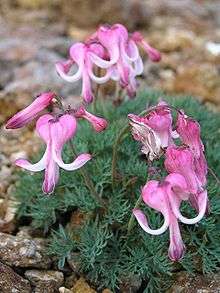 | |
| Scientific classification | |
| Kingdom: | Plantae |
| Clade: | Tracheophytes |
| Clade: | Angiosperms |
| Clade: | Eudicots |
| Order: | Ranunculales |
| Family: | Papaveraceae |
| Genus: | Dicentra |
| Species: | D. peregrina |
| Binomial name | |
| Dicentra peregrina (Rudolph) Makino | |
Etymology
The species name peregrina is Latin for "exotic, alien, foreign, strange, from foreign lands", possibly because the species is the only one of its genus outside of North America.[1]
In Japanese, the plant (kusa)[2] is named for the buds, which look like the head of a horse (koma).[3]
Description
Leaves are gray-green, glaucous, and deeply cut, with linear lobes.
Flowers have four rose-purple, pink, cream, pale yellow, or white petals and two tiny sepals. Outer petals are pouched at the base and strongly bent back at the ends. Inner petals are long and protruding, connected at the end.
- A plant in early spring before flowering on Mount Ontake
- A plant in bud
 A plant with many flowers
A plant with many flowers
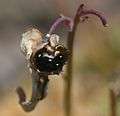 A broken pod with seed
A broken pod with seed
Ecology
Komakusa grows in Japan, the Kuril Islands, Sakhalin Island, and northeastern Siberia, including the Kamchatka Peninsula.[1] It favors gravelly soil at high altitudes, 3,350 m (10,990 ft), in alpine tundra.[4]
- Wild plants
 Gravelly alpine area scattered with komakusa on Mount Yari in the Hida Mountains
Gravelly alpine area scattered with komakusa on Mount Yari in the Hida Mountains- Komakusa plants on Mount Norikura
 A deep pink komakusa in bloom with mountain as background
A deep pink komakusa in bloom with mountain as background
Cultivars
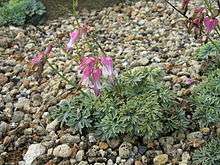
There are several hybrid cultivars, cultivated as ornamental plants, involving Dicentra eximia, Dicentra formosa, and Dicentra nevadensis.
- Dicentra 'Candy Hearts' (D. eximia × D. peregrina)
rose-pink flowers - Dicentra 'Gothenburg' (D. formosa subsp. oregana × D. peregrina f. alba) – light pink flowers
- Dicentra 'Ivory Hearts' (D. eximia × D. peregrina)
white flowers - Dicentra 'King of Hearts' – D. peregrina × (D. formosa subsp. oregana × D. eximia)
pink flowers - Dicentra 'Luxuriant' (D. eximia × D. peregrina)
cherry-red flowers - Dicentra 'Tsuneshigo Rokujo' (D. nevadensis × D. peregrina)
pink flowers
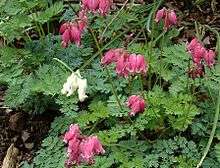 Dicentra 'King of Hearts'
Dicentra 'King of Hearts'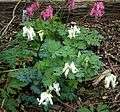 Dicentra 'Ivory Hearts'
Dicentra 'Ivory Hearts'
References
- Tebbitt, Mark; Lidén, Magnus; Zetterlund, Henrik (2008). Bleeding hearts, Corydalis, and their relatives. Timber Press. pp. 71, 72.CS1 maint: ref=harv (link)
- くさ kusa in Japanese Kanji dictionary
- コマクサ komakusa on Japanese Wikipedia, ja:コマクサ
- Tebbitt, Mark; Lidén, Magnus; Zetterlund, Henrik (2008). Bleeding hearts, Corydalis, and their relatives. Timber Press. pp. 56–58.CS1 maint: ref=harv (link)
- Bleeding hearts, Corydalis, and their relatives. Mark Tebbitt, Magnus Lidén, and Henrik Zetterlund. Timber Press. 2008. — Google Books
External links
| Wikimedia Commons has media related to Dicentra peregrina. |
| Wikispecies has information related to Dicentra peregrina |